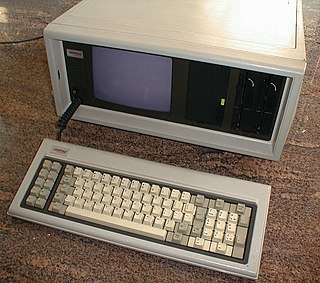
The IBM Personal Computer is the first microcomputer released in the IBM PC model line and the basis for the IBM PC compatible de facto standard. Released on August 12, 1981, it was created by a team of engineers and designers directed by Don Estridge in Boca Raton, Florida.
Tandy Corporation was an American family-owned leather-goods company based in Fort Worth, Texas, United States. Tandy Leather was founded in 1919 as a leather supply store. By the end of the 1950s, under the tutelage of then-CEO Charles Tandy, the company expanded into the hobby market, making leather moccasins and coin purses, making huge sales among Scouts, leading to a fast growth in sales.

A graphics tablet is a computer input device that enables a user to hand-draw images, animations and graphics, with a special pen-like stylus, similar to the way a person draws images with a pencil and paper. These tablets may also be used to capture data or handwritten signatures. It can also be used to trace an image from a piece of paper that is taped or otherwise secured to the tablet surface. Capturing data in this way, by tracing or entering the corners of linear polylines or shapes, is called digitizing.

GEM is a discontinued operating environment released by Digital Research in 1985. GEM is known primarily as the native graphical user interface of the Atari ST series of computers, providing a WIMP desktop. It was also available for IBM PC compatibles and shipped with some models from Amstrad. GEM is used as the core for some commercial MS-DOS programs, the most notable being Ventura Publisher. It was ported to other computers that previously lacked graphical interfaces, but never gained traction. The final retail version of GEM was released in 1988.

Wang Laboratories was a US computer company founded in 1951 by An Wang and G. Y. Chu. The company was successively headquartered in Cambridge, Massachusetts (1954–1963), Tewksbury, Massachusetts (1963–1976), and finally in Lowell, Massachusetts (1976–1997). At its peak in the 1980s, Wang Laboratories had annual revenues of US$3 billion and employed over 33,000 people. It was one of the leading companies during the time of the Massachusetts Miracle.

A portable computer is a computer designed to be easily moved from one place to another, as opposed to those designed to remain stationary at a single location such as desktops and workstations. These computers usually include a display and keyboard that are directly connected to the main case, all sharing a single power plug together, much like later desktop computers called all-in-ones (AIO) that integrate the system's internal components into the same case as the display. In modern usage, a portable computer usually refers to a very light and compact personal computer such as a laptop, miniature or pocket-sized computer, while touchscreen-based handheld ("palmtop") devices such as tablet, phablet and smartphone are called mobile devices instead.

Calcomp plotters were the best known products of the California Computer Products company.

AST Research, Inc., later doing business as AST Computer, was a personal computer manufacturer. It was founded in 1980 in Irvine, California, by Albert Wong, Safi Qureshey, and Thomas Yuen, as an initialism of their first names. In the 1980s, AST designed add-on expansion cards, and evolved toward the 1990s into a major personal computer manufacturer. AST was acquired by Samsung Electronics in 1997 but was de facto closed in 1999 due to a series of losses.

TigerDirect was an El Segundo, California-based online retailer dealing in electronics, computers, and computer components. The company was previously owned by Systemax, which is known for its acquisitions of the intellectual property of the defunct U.S. retail chains Circuit City and CompUSA and relaunching them as online retailers. The two brands were subsequently shuttered in late-December 2012 and consolidated into the TigerDirect site.

Travelstar was a brand of 2.5-inch hard disk drive (HDD) that was introduced by IBM in 1994 with the announcement of the Travelstar LP. At 12.5 mm high with two platters, they were available in 360, 540 and 720 MB capacities. Initial models were industry-leading for small form factor HDDs in terms of areal density, data transfer rates and shock tolerance (500g).

Hardcard is the genericized trademark for a hard disk drive, disk controller, and host adapter on an expansion card for a personal computer.
Heinz Joseph Gerber was an American inventor and businessman. An Austrian-born Jewish Holocaust survivor who immigrated in 1940, he pioneered computer-automated manufacturing systems for an array of industries. Described as the "Thomas Edison of manufacturing", he was one of the first to recognize and develop the productivity-enhancing potential for computer automation in skill-intensive industrial sectors.
FlexOS is a discontinued modular real-time multiuser multitasking operating system (RTOS) designed for computer-integrated manufacturing, laboratory, retail and financial markets. Developed by Digital Research's Flexible Automation Business Unit in Monterey, California, in 1985, the system was considered to become a successor of Digital Research's earlier Concurrent DOS, but with a new, modular, and considerably different system architecture and portability across several processor families. Still named Concurrent DOS 68K and Concurrent DOS 286, it was renamed into FlexOS on 1 October 1986 to better differentiate the target audiences. FlexOS was licensed by several OEMs who selected it as the basis for their own operating systems like 4680 OS, 4690 OS, S5-DOS/MT and others. Unrelated to FlexOS, the original Concurrent DOS system architecture found a continuation in successors like Concurrent DOS XM and Concurrent DOS 386 as well.
This article presents a timeline of events in the history of 16-bit x86 DOS-family disk operating systems from 1980 to present. Non-x86 operating systems named "DOS" are not part of the scope of this timeline.

Plus Development Corporation was a majority-owned subsidiary of Quantum Corporation. The company invented the Hardcard, a hard disk drive on an expansion card, which started a wave of companies producing similar products in the 1980s.
P-CAD was the brand name of Personal CAD Systems, Inc., a California based manufacturer of electronic design automation software. It manufactured a CAD software available for personal computers. The company was divested into ACCEL Technologies which was purchased by Altium in 2000. The last release of the software was in 2006 before it was retired in favor of the Altium Designer product.

Billings Computer Corporation was a publicly traded computer company and fully owned subsidiary of Billings Energy Corporation, a defunct American energy company based in Provo, Utah, that specialized in hydrogen fuel. Billings Computer was active between 1977 and 1985 and released several minicomputers and microcomputer systems.
The Dot was a portable computer released by Computer Devices, Inc., in April 1983.














